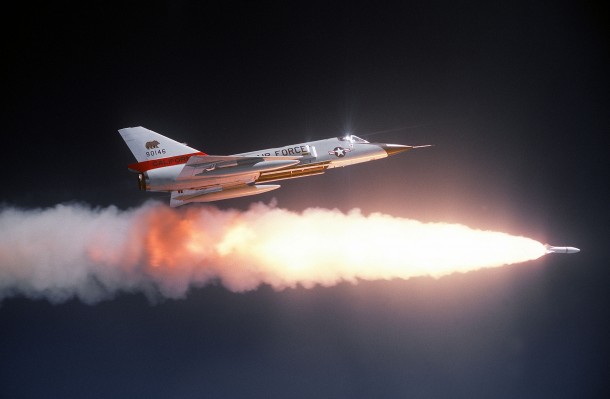
Fifty-seven years ago this month, the United States successfully conducted the only live-fire test of the only known nuclear-armed air-to-air missile ever developed by the West. The test took place in the skies over the Nuclear Test Site located at Yucca Flats, Nevada.
The Cold War between the Soviet Union and the United States gave rise to the development of myriad nuclear weapons. Both superpowers ultimately relied on a triad of platforms, consisting of bombers, missiles and submarines, to deliver nuclear ordnance. Each side used these same types of platforms in a defensive role as well.
The United States employed land-based interceptor aircraft for defending against the Soviet bomber threat. These aircraft would go out to engage and destroy Soviet bomber groups before the latter could penetrate US airspace. The weapon of choice for taking out the bombers was the air-to-air missile.
The most fearsome of air-to-air missiles was armed with a nuclear warhead. The idea was simple. A defending aircraft would fire the nuclear-armed missile into a bevy of Soviet bombers. Detonation of the warhead would in theory destroy an entire bomber group with a single atomic blast.
The Douglas Aircraft Company produced just such a missile for the United States Air Force in the mid-1950′s. The subject missile was originally known as the MB-1 Genie (aka Bird Dog, Ding-Dong, and High Card). The type’s 1.5 kiloton nuclear device had a blast radius on the order of 1,000 feet.
The Genie measured 9.67 feet in length and had a nominal diameter of 17.5 inches. Firing weight was 822 pounds. Genie’s Thiokol SR49-TC-1 solid rocket motor had a rated thrust of 36,500 pounds. The resulting high thrust-to-weight ratio allowed the missile to quickly accelerate to the target. Genie had a top Mach number of 3.3 and a range of slightly over 6 miles.
Genie was carried by the top USAF interceptor aircraft of its day; the Northrop F-89 Scorpion, McDonnell F-101B VooDoo and Convair F-106 Delta Dart. The missile was unguided. That is, Genie was simply a point and shoot weapon. The warhead would detonate only after rocket motor burnout. This delay permitted the carrier aircraft to quickly depart the area following launch.
The only in-flight detonation of a Genie warhead occurred during the summer of 1957 as part of Operation Plumbbob. This program was series of nuclear weapons tests conducted from May to October of the subject year at the Yucca Flats Nuclear Test Site in Nevada.
At 1400 UTC on Friday, 19 July 1957, USAF Captain Eric Hutchison fired a single Genie missile from his Northrop F-89J aircraft. The missile’s W25 warhead detonated at 15,000 feet above ground level shortly after rocket motor burnout. A group of USAF officers was positioned directly below the air burst to prove that the missile could be used over populated areas. The men were reported to be unharmed.
Genie was never fired in anger. Approximately 3,150 missiles were produced by the time Thiokol closed down the production line in 1963. This production run included a number of improved variants known as the MB-1-T, ATR-2A, AIR-2A and AIR-2B. Genie ultimately served with both the USAF and the Canadian Air Force. It was withdrawn from service in 1985.
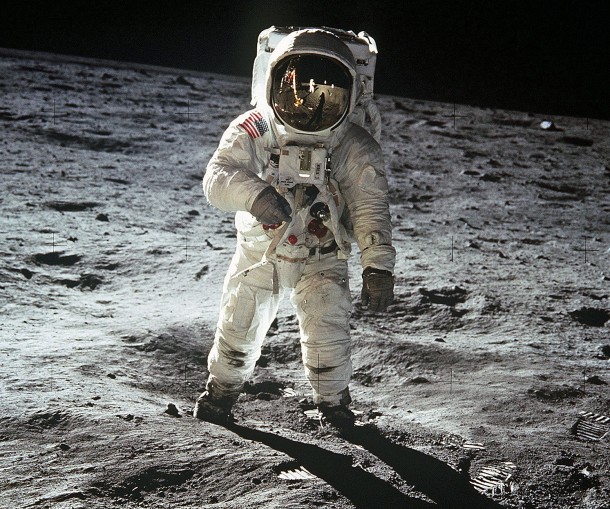
Forty-five years ago yesterday, the United States of America first landed men on the surface of the Moon.
The Apollo 11 Lunar Module Eagle landed in Sea of Tranquility region of the Moon on Sunday, 20 July 1969 at 20:17:40 UTC. Less than seven hours later, astronauts Neil A. Armstrong and Edwin E. Aldrin, Jr. became the first human beings to walk upon Earth’s closest neighbor. Fellow crew member Michael Collins orbited high overhead in the Command Module Columbia.
As Apollo 11 commander, Neil A. Armstrong was accorded the privilege of being the first man to step foot upon the Moon. As he did so, Armstrong spoke these words: “That’s one small step for Man; one giant leap for Mankind”. He had intended to say: “That’s one small step for ’a’ man; one giant leap for Mankind”.
Armstrong and Aldrin explored their Sea of Tranquility landing site for about two and a half hours. Total lunar surface stay time was 22 hours and 37 minutes. The Apollo 11 crew left a plaque affixed to one of the legs of the Lunar Module’s descent stage which read: “Here Men From the Planet Earth First Set Foot Upon the Moon; July 1969, A.D. We Came in Peace for All Mankind”.
Following a successful lunar lift-off, Armstrong and Aldrin rejoined Collins in lunar orbit. Approximately seven hours later, the Apollo 11 crew rocketed out of lunar orbit to begin the quarter million mile journey back to Earth. Columbia splashed-down in the Pacific Ocean at 16:50:35 UTC on Thursday, 24 July 1969. Total mission time was 195 hours, 18 minutes, and 35 seconds.
With completion of the flight of Apollo 11, the United States of America fulfilled President John F. Kennedy’s 25 May 1961 call to land a man on the Moon and return him (them) safely to the Earth before the decade of the 1960′s was out. It had taken 2,982 demanding days and much national treasure to do so.
Mission Accomplished, Mr. President.
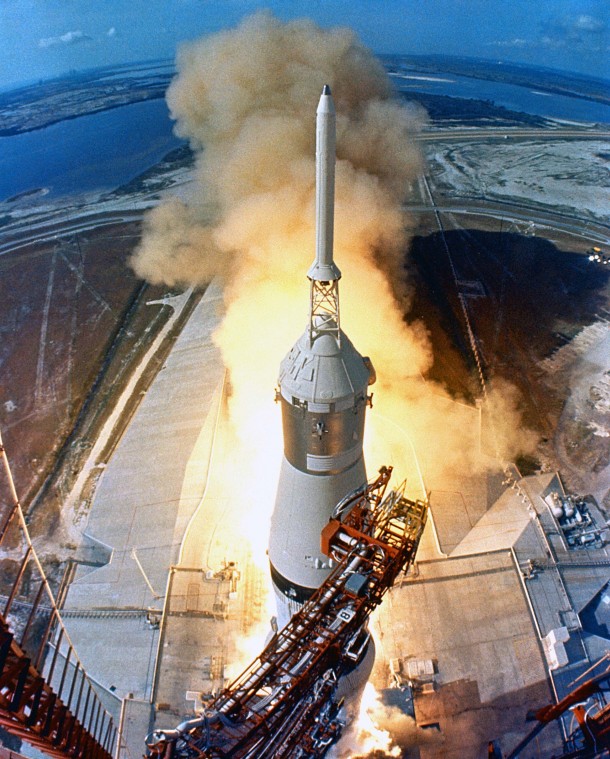
Forty-five years ago today, the epic flight of Apollo 11, the first mission to land men on the Moon, began with launch from the Kennedy Space Center (KSC) at Merritt Island, Florida. Nearly 1-million people gathered around America’s famous space complex to witness the historic event. An estimated 1-billion viewers worldwide watched the proceedings on television.
The names of the Apollo 11 crew are now legend: Mission Commander Neil A. Armstrong, Lunar Module Pilot Edwin E. Aldrin, Jr., and Command Module Pilot Michael Collins. Each astronaut was making his second spaceflight.
The overall Apollo 11 spacecraft weighed roughly 100,000 pounds and consisted of 3 major components: Command Module, Service Module, and Lunar Excursion Module (LEM). Out of American history came the names used to distinguish two of these components from one another. The Command Module was named Columbia, the feminine personification of America, while the Lunar Excursion Module received the appellation Eagle in honor of America’s national bird.
The Apollo-Saturn V launch stack measured 363-feet in length, had a maximum diameter of 33-feet, and weighed 6.7-milllion pounds at ignition of its five F-1 engines. The vehicle rose from the Earth on 7.7-million pounds of lift-off thrust.
The acoustic energy produced by the Saturn’s first stage propulsion system was unlike anything in common experience. The sound produced was like intense, continuous thunder even miles away from the launch point. Ground and structure shook disturbingly and a person’s lungs vibrated within their chest cavity.
Lift-off of Apollo 11 (AS-506) from KSC’s LC-39A occurred at 13:32 UTC on Wednesday, 16 July 1969. The target for the day’s launch, the Moon, was 218,096 miles distant from Earth. It took 12 seconds just for the massive Apollo 11 launch vehicle to clear the launch tower. However, a scant 12 minutes later, the Apollo 11 spacecraft was safely in low earth orbit (LEO) traveling at 17,500 miles per hour.
Following checkout in earth orbit, trans-lunar injection, and earth-to-moon coast, Apollo 11 entered lunar orbit nearly 76 hours after lift-off. Now, the big question: Would they make it? Even Apollo 11′s Command Module Pilot, Michael Collins, estimated that the chance of a successful lunar landing on the first attempt was only 50/50. The answer would soon come. History’s first lunar landing attempt was now only 24 hours away.
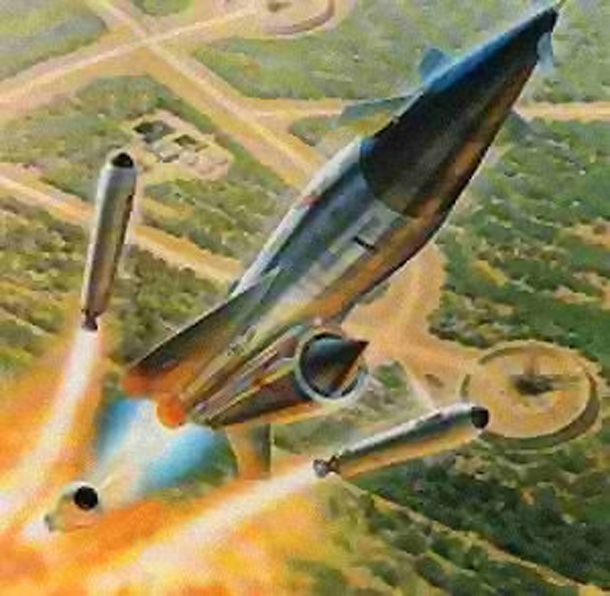
Fifty years ago this month, the United States abandoned a 7-year effort to develop a nuclear-armed, supersonic cruise missile. The joint USAF-AEC program was known as Project Pluto. The centerpiece of this program was the nuclear-fueled, ramjet-powered Supersonic Low-Altitude Missile (SLAM).
The 1950′s saw the development of myriad aircraft, missile and submarine concepts designed for delivery of nuclear weaponry over strategic distances. This developmental activity was driven by the escalating Cold War between the United States and the Soviet Union. In addition to weapons, the power of the atom was also considered for propulsion applications during this era.
SLAM was perhaps the most fearsome weapon ever conceived. The missile was designed to deliver as many as 26 nuclear bombs over the Soviet Union in a single mission. It would do this while flying at Mach 3 and less than 1,000 feet above ground level. SLAM’s shock wave overpressure alone (162 dB) would devastate structures and people along its flight path. And, as if that were not enough, the type’s nuclear-fueled ramjet would continuously spew radiation-contaminated exhaust all over the countryside.
The SLAM airframe was huge. It measured 88 feet in length, nearly 6 feet in diameter and weighed 61,000 pounds at launch. The vehicle would be fired from a ground-based launch site and accelerated to ramjet takeover speed by a trio of jettisionable rocket boosters. The nuclear-fueled ramjet was rated at 35,000 pounds of thrust.
To find its way to the target area(s), the Ling-Temco-Vought (LTV) SLAM would use a guidance system known today as TERCOM – Terrain Contour Matching. At a target, SLAM would eject an atomic warhead upwards from its payload bay. The resulting lofted trajectory gave SLAM time to depart the hot target area prior to weapon detonation. Following completion of its mission, the missile would then ditch itself by diving into a deep ocean graveyard.
The heart of the Project Pluto missile was the nuclear-fueled ramjet. An unshielded nuclear reactor, code named TORY, was devised, built and successfully tested. Testing was conducted at a special-purpose test site in Nevada. In its Tory II-C configuration, the SLAM ramjet produced over 500 megawatts of power in 5 minutes of continuous operation during a test conducted in May of 1964.
SLAM’s nap-of-the-earth, supersonic flight profile would subject the airframe to terrific airloads, vibrations and temperatures. The Project Pluto team successfully devised structural and thermal material solutions to handle the daunting flight environment. In addition, nuclear-hardened electronics and flight controls were successfully developed.
From a technological standpoint, Project Pluto proved to be entirely viable. However, doubts about its implementation started to arise as flight testing of the nuclear-powered missile was seriously considered. Where do you flight-test a radiation-spewing missile? What happens if you can’t turn-off the reactor? What do you do if the guidance system fails? Where do you dispose of the missile after a flight test? These and other disturbing questions began to trouble program officials.
Coupled with the above practical concerns of SLAM flight testing were growing political and mission obsolesence issues. Pentagon officials ultimately deemed Project Pluto as being highly provocative to the Soviet Union in the sense that the communist super power might feel compelled to develop their own SLAM. Further, American missilery was quickly developing to the point where ICBM-delivered warheads would do the job and at a lower per-unit cost.
So it was that on Wedneday, 01 July 1964, Project Pluto was canceled after 7 years of fruitful development. While no airframe was ever built and tested, SLAM technology was applied to a host of subsequent aerospace vehicle developments.
SLAM would truly have been “The Missile From Hades” had it matured to the point of flight. Indeed, the ethical issues concerning the missile’s use were quite sobering. And, owing to Murphy’s Law and its many corollaries, the chances for unintended catastrophe were high as well. Despite the allure of this ”technically sweet” solution to a national defense problem, the decision to cancel Project Pluto was ultimately the only correct course to follow.
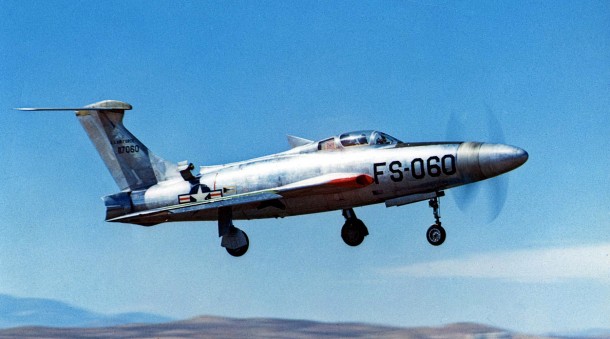
Fifty-nine years ago this month, the USAF/Republic XF-84H experimental turboprop fighter took to the air for the first time. The test hop originated from and recovered at Edwards Air Force Base, California.
The turbojet-powered XF-84H was a variant of Republic Aviation’s F-84 Thunderstreak. An Allison XT40-A-1 turboprop engine, rated at 5,850 hp, served as the power source for this novel aircraft. The XT40 drove a variable-pitch, 3-blade, 12-foot diameter propeller at 3,000 rpm. The propulsion system’s thrust level was changed by varying blade pitch.
Owing to its high rotational speed and large diameter, the outer 2 feet of the XF-84H propeller saw supersonic velocities. The shock waves that emanated from the prop produced a deafening wall of sound. The extreme sound level produced intense nausea and raging headaches in ground crewmen. As a result, the XF-84H was dubbed the Thunderscreech.
The prop wash from the aircraft’s powerful turboprop necessitated the use of a T-tail to keep the horizontal tail and elevator in clean air flow. The engine’s extreme torque was partially countered by incorporating differential deflection on the left and right wing flaps and by placement of the left wing root air intake a foot ahead of the right intake.
A pair of XF-84H prototype aircraft (S/N 51-17059 and S/N 51-17060) was built by Republic Aviation. The first flight of an XF-84H took place on Friday, 22 July 1955 at Edwards Air Force. The flight was made by Republic test pilot Henry G. “Hank” Beaird, Jr. in Ship No. 1 (S/N 51-17059). The flight was cut short by a forced landing.
A total of twelve (12) test flights were made in the two Thunderscreech prototypes; eleven (11) in Ship No. 1 and one (1) in Ship No. 2. Total flight time accumulated by these experimental airframes was 6 hours and 40 minutes. The majority of flights experienced forced landings for one reason or another.
The XF-84H suffered from reduced longitudinal stability and poor handling qualities. The aircraft was also plagued by frequent engine, hydraulic system, nose gear and vibration problems. Faced with the type’s obvious non-viability, USAF opted to cancel the XF-84H Program in September of 1956.
Historical records indicate that the XF-84H reached a top speed of 520 mph during its brief flight test life. This mark was a full 120 mph short of the aircraft’s design speed. Nonetheless, the XF-84H held the speed record for single-engine prop-driven aircraft until Monday, 21 August 1989. On that date, a specially modified Grumman F8F Bearcat established the existing record of 528.33 mph.





